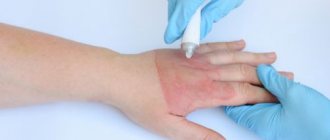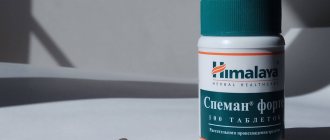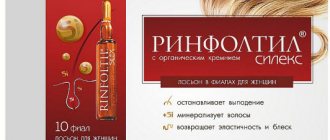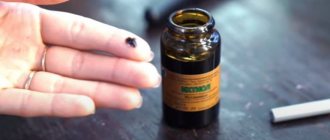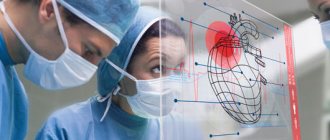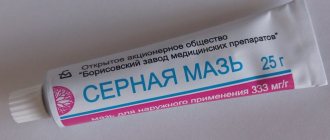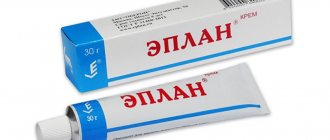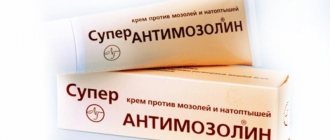- Composition and effect of Levomekol ointment
- Indications and contraindications for the use of Levomekol ointment
- Levomekol ointment - instructions for use
- Levomekol during pregnancy and children
- Levomekol for acne
- Levomekol for lips
- Levomekol ointment for boils
- Levomekol ointment for stitches
- Levomekol ointment in gynecology
- Treatment of wounds with Levomekol ointment
- Treatment of balanoposthitis with Levomekol ointment
- Analogs of Levomekol ointment
- Voskopran with Levomekol
Levomekol ointment, “the doctor’s favorite assistant,” has long established itself as an effective antibacterial agent that accelerates wound healing and helps restore normal structures of damaged skin.
| Being both an antibiotic and a reparative, Levomekol ointment has become one of the most popular ointments among surgeons in the treatment of deep ulcers, wounds of varying complexity and in restoring the integrity of the skin after suturing. |
Composition and effect of Levomekol ointment
The composition of 1.0 g of Levomekol ointment includes chloramphenicol 7.5 mg, methyluracil 40 mg, the base is polyethylene oxide 1500 and polyethylene oxide 400. Chloramphenicol is a broad-spectrum antibiotic, methyluracil is a drug that improves tissue trophism and stimulates the regeneration process. The combination of these two components makes wound healing successful and fast: thanks to Levomekol, the site of injury is protected from infections and at the same time supported by an effect that stimulates healing. Polyethylene oxide 1500 and polyethylene oxide 400 are auxiliary components; they facilitate uniform application of the ointment and help the active ingredients penetrate the tissues of the human body.
The main forms of release of the ointment are an aluminum tube (25g, 30g and 40g) or a dark glass jar (100g and 1000g each). The structure of the ointment is homogeneous and of medium thickness.
Levomekol, having anti-inflammatory, antibacterial and regenerating effects, belongs to the drugs with a combined spectrum of action.
Thanks to chloramphenicol, the ointment is effective in the fight against resistant gram-negative microorganisms, such as Pseudomonas aeruginosa and Escherichia coli, staphylococcus spp., etc. Frequent or extensive use of the ointment can cause microorganisms to become resistant to the drug, but this process happens relatively slowly.
Thanks to methyluracil, which easily penetrates the surface layers of the skin and accelerates the growth of new cells and the regeneration of damaged ones, the healing rate of wounds, cuts and postoperative sutures increases significantly. Moreover, methyluracil is an immune stimulant, which helps increase the production of interferon, a natural antiviral substance.
Excipients from Levomekol ointment help the active components penetrate deep into cell membranes without damaging them, creating an anti-inflammatory, decongestant and therapeutic effect.
The presence of pus or a large number of dead cells in the wound does not affect the effectiveness of Levomekol ointment.
Levomekol ointment has virtually no contraindications, with the exception of increased sensitivity to the components included in its composition, which in rare cases causes external allergic reactions. Moreover, there are no known cases of drug overdose, which indicates the harmlessness of its use among wide groups of people (including pregnant women, children). The ointment is indicated exclusively for external use, which determines the scope of its use - the skin.
Levomekol
Levomekol is an ointment for local application with an anti-inflammatory effect that destroys intestinal, Pseudomonas aeruginosa, and staphylococci. Penetrating into the deep epidermal layers, the ointment accelerates healing, but does not disrupt biological membranes. Retains an antibacterial effect also in purulent inflammations.
Heals wounds, burns, activates tissue restoration. It is used externally to destroy viral and microbial infections and activate the synthesis of immunostimulants. For open wounds, surgery, and in gynecology it is used to prevent pathogenic flora. These are the main points that Levomekol helps with. It is also used for other purposes, for example, to eliminate wrinkles.
Compound
The main components of Levomekol ointment:
- Chloramphenicol 7.5 mg. An antibiotic used externally to treat trophic ulcers, infected burns, cracked nipples, boils, bacterial skin infections, wounds. It is active against chlamydia, bladder infections, purulent peritonitis, wound infections, due to which it has found application in gynecology.
- Macrogol 400 and 1500 are excipients.
- Methyluracil 40 mg is a component that stimulates tissue regeneration, enhancing the restoration of tissue and cellular structures. Accelerates the restoration of mucous membranes and skin. It is used in the treatment of burns, poorly healing wounds, cuts, fractures, bedsores, and for the treatment of postoperative sutures.
Mechanism of action
The ingredients Chloramphenicol and methyluracil guarantee the therapeutic effect of Levomekol ointment.
The medicine acts on the integument and mucous membranes in the following way:
- destroys pathogenic microbes;
- disrupts protein synthesis in bacteria;
- blocks enzymes of microbial cells;
- prevents vital activity and proliferation of harmful microorganisms;
- eliminates burning sensation;
- destroys spirochetes, E. coli, Proteus, enterobacteria, streptococci, salmonella, staphylococci, yersinia, gonococci, chlamydia, strains that cannot be treated with antibiotics, some viruses, meningococci, anaerobic microorganisms;
- stimulates the skin's defenses;
- activates metabolism;
- relieves the inflammatory process;
- heals mucous membranes and skin.
Indications for use
Levomekol ointment has proven itself well as a bactericidal, anti-inflammatory, antiviral, and regenerative agent. Therefore, it is used in dermatology, gynecology, surgery, veterinary medicine, urology, dentistry and other industries.
- In gynecology, Levomekol is used for salpingitis, cervical erosion, bacterial vaginosis, bacterial colpitis, vulvitis of various origins, genital herpes, vaginal dysbiosis, gonorrhea, injuries to the skin and mucous membranes, candidiasis.
- Proctologists recommend Levomekol for hemorrhoids to destroy bacteria and inflammation. The ointment restores the mucous membrane.
- Ophthalmologists also use this remedy in the complex therapy of conjunctivitis.
- In surgery, Levomekol is applied to fresh sutures to avoid suppuration, infection, and for healing.
- Dermatologists have found the use of ointments for inflammation, boils, acne, swelling, abscesses, insect bites, cuts, any wounds, burns, abscesses, bedsores. Stops the purulent process in the presence of trophic ulcers, ulcers caused by diabetes, gangrene. Heals cracked nipples, treats mastitis.
Contraindications and side effects
Avoid using Levomekol ointment in the following cases:
- lymphogranulomatosis (malignant tumors on lymphoid tissue);
- malignant bone marrow diseases;
- chronic, acute forms of leukemia;
- hemoblastosis;
- personal intolerance to ingredients;
- wound granulation (healing stage);
- age up to 3 years.
Overdose
There are no cases of overdose of the drug, because the ointment is used externally. The second factor is the low toxicity of the product. Due to this, Levomekol is used even during pregnancy and lactation.
special instructions
Levomekol is an ointment that is effective at the primary stage of skin trauma, until granulation tissue appears. It should be applied only to treat the wound surface in the stage of inflammation, when there is increased local temperature, swelling, redness, and pain. In subsequent phases, when the healing process has begun, Levomekol is replaced with other means. In these cases, the ointment can negatively affect young skin cells, leading to their dehydration.
Regardless of the size of the treated area, the amount of ointment should not exceed 3 g per day.
Indications and contraindications for the use of Levomekol ointment
Frequent diseases and disorders for which Levomekol ointment is indicated are wounds with pus, wounds infected with mixed pathogenic microflora, and boils. The drug helps stop the inflammatory process, stop the infection zone, destroys dangerous microflora, and also relieves swelling at the site of the lesion.
The main indications for the use of Levomekol ointment are:
- Trophic ulcers.
- Boils.
- Purulent-inflammatory skin diseases.
- Second and third degree burns.
Prophylactic indications for the use of Levomekol:
- Seams.
- Wounds.
- Cuts.
- Calluses.
- Eczema.
- Bedsores.
The only reason for refusing to use Levomekol ointment may be increased sensitivity to the active substances included in the drug. It is worth noting that long-term use of the ointment can provoke an allergic skin reaction, but cases of allergies are scanty. Chronic diseases or other disorders are not a contraindication to use.
Levomekol ointment - instructions for use
As already mentioned, Levomekol ointment is used exclusively externally. A thin layer of the drug is applied to the affected or damaged surface, after which the treated area of skin is tightly covered with sterile gauze or bandage rolled up in several layers (4-5).
Treatment of the wound surface is repeated several times a day for 5–10 days until the injury site is completely cleared of pus.
If the wound is deep and large, abundantly filled with pus or located in a body cavity, then the ointment is used in the form of a tampon (also made from a sterile bandage or gauze), which is inserted into the wound surface. Before the procedure, Levomekol is heated to 35 degrees, after which the tampon is generously soaked in ointment and slowly, consistently immersed in the wound until it is completely loosely filled.
If the wound has a shape that does not allow the installation of a tampon, the ointment is administered through a drainage tube using a medical catheter. The ointment slowly fills the wound through the tube, after which a fixing bandage is applied to it. The frequency of changing a bandage, tampon, or flap depends on the rate of its filling with purulent masses and necrotic particles of human tissue.
Napkins with Levomekol are replaced with new ones as they become saturated with pus and the accumulation of necrotic masses in them. If the wound is not deep, dressing is indicated once a day; in other cases, with severe infection and the presence of a large amount of pus, the dressings are changed 4-6 times a day. If the dressing was skipped, treatment is continued according to the previously planned schedule.
Levomekol is often used for minor disorders, such as purulent pimples, cuts and torn calluses. The scope of indications for the ointment also includes the treatment of bedsores in bedridden patients.
Levomekol ointment is often used for inflammatory processes in the auditory canal of the external ear. To do this, make a thin gauze tourniquet, soak it in ointment and place it shallowly in the ear for twelve hours. In the same way, Levomekol on gauze tourniquets is injected into the nasal passages and sinuses for sinusitis.
For purulent acne rashes, it is recommended to lubricate the affected area (at night) with a small layer of Levomekol ointment. After rupture of the pustule or mechanical removal of pus, the procedure should be repeated.
When using Levomekol externally, it is not recommended When applying the ointment, you must be careful and avoid the eye area and mucous membranes. Internal use of Levomekol is prohibited. If caution has not been observed, if the drug gets into the eyes or mucous membranes, rinse them with plenty of clean water, and in case of ingestion, rinse the stomach with water and activated charcoal.
Antihistamines in the treatment of urticaria
Urticaria is clinically characterized by the appearance of itchy, urticarial rashes on the skin. A wheal, the main morphological element of urticaria, is a limited swelling of the dermis with a diameter of several millimeters to several centimeters, hyperemic along the periphery and paler in the center. When edema spreads to the deep layers of the dermis and subcutaneous tissue, as well as mucous membranes, Quincke's edema (angioedema) is formed.
Quincke's edema occurs quite often. It is believed that 15–20% of the population have experienced at least one episode of urticaria [15]. The prevalence of all types of urticaria in children ranges from 2.1–6.7% [8].
In recent years, the classification of urticaria has been widely discussed.
The published consensus document [12, 13] categorizes urticaria into spontaneous, physical and special types. This classification is aimed at practicing physicians and is convenient for clinicians.
The etiological factors of urticaria are presented in Table 1.
Spontaneous urticaria
Spontaneous urticaria is divided into acute and chronic according to the duration of its course. Acute urticaria lasts up to 6 weeks. Chronic urticaria persists for more than 6 weeks and has an undulating course with alternating relapses and remissions.
Acute urticaria . The main etiological factors of acute urticaria (AU) are foods and drugs. The development of urticaria is possible with allergies to epidermal allergens (cat, dog), house dust mites and pollen allergens, hymenoptera venom (bees, wasps) [2, 7, 11].
Most often, the disease is caused by the development of IgE-dependent allergic reactions. Many studies have shown a high incidence of OK in patients with atopic diseases [3, 7, 12]. An analysis of clinical symptoms in children with food allergies conducted by I. Dalal et al. found that OK alone or in combination with angioedema was the most common clinical symptom of food allergy and was observed in 74.4% of cases [7].
A study conducted by T. Zuberbier et al. found that 50.2% of patients with acute urticaria had concomitant allergic diseases - hay fever, bronchial asthma, atopic dermatitis [16].
The development of urticaria may be due to the direct release of histamine and other biologically active substances from mast cells without the participation of immunological mechanisms. A number of foods, drugs, and chemicals can cause mast cell degranulation. Eating foods rich in histamine can also cause urticaria (Table 2).
Chronic urticaria (CU) . According to most authors, the most common causes of spontaneous chronic urticaria are infections - hepatitis, Helicobacter pylori-associated gastritis, staphylococcal and streptococcal infections. Foods and medications can also maintain chronic symptoms of urticaria, but, unlike acute urticaria, the role of IgE-dependent reactions in the formation of symptoms is minimal [2, 6, 11, 16].
Of great interest is the frequency of detection of autoantibodies to high-affinity IgE receptors (FceRI) and to IgE in patients with CC. The autoimmune genesis of urticaria is confirmed by skin tests with autoserum. There is still no consensus regarding the role of autoantibodies in the formation of urticaria symptoms; further research is needed.
In many cases, urticaria can be caused by diseases of the gastrointestinal tract, intestinal dysbiosis, and parasitic infestations.
Physical urticaria
Physical urticaria (PH) develops due to exposure to physical factors. The mechanism of development of the disease is not well understood. An important role of mast cell degranulation in the formation of FC symptoms has been suggested. Physical urticaria includes cold urticaria, solar urticaria, heat urticaria, dermographic urticaria, vibration urticaria and pressure urticaria.
Special forms of urticaria are cholinergic, adrenergic, aquagenic.
Treatment of urticaria
Treatment of urticaria largely depends on the form of the disease and causative factors. Nevertheless, the basic principles of therapy are the same; they include the following steps.
- Eliminating or limiting exposure to factors that cause urticaria.
- Conducting pharmacotherapy.
- Detailed examination of patients, treatment of diseases that may cause urticaria.
Pharmacotherapy . In patients with acute urticaria, exacerbation of chronic or physical urticaria, in order to relieve the acute condition, in most cases, the prescription of second-generation antihistamines is indicated. In more severe cases of the disease, parenteral administration of first-generation antihistamines is advisable (second-generation H1-blockers do not have dosage forms for parenteral administration), as well as glucocorticosteroids.
Treatment of patients with chronic urticaria requires great patience and close cooperation between the doctor and the patient. The quality of life of patients is seriously affected: itching can affect daily activity, disrupt sleep, rashes on the face embarrass the patient, severely limit his communication and professional activities. Patients require frequent and long-term use of antihistamines. First generation antihistamines have a number of undesirable effects that limit their use. The sedative effect and impairment of cognitive and psychomotor functions of the central nervous system are well known [4]. Low selectivity and binding of M-cholinergic receptors manifest themselves in dry mucous membranes of the oral cavity; in patients with bronchial asthma, the viscosity of sputum increases, which negatively affects the course of the disease. Urinary retention, constipation, and a possible increase in intraocular pressure limit the prescription of drugs to patients with concomitant diseases. An equally serious disadvantage of first-generation H1-blockers is their short-term action, the need for 3-4 doses per day, and fairly high doses. A decrease in therapeutic effectiveness with long-term use dictates the need to change the drug every 10–14 days.
Second generation antihistamines (desloratadine, loratadine, fexofenadine, cetirizine, ebastine) do not have these disadvantages. All drugs have a high safety profile, no serious side effects, and are easy to use. New antihistamines are prescribed once a day, regardless of food intake; there is no need to change drugs, since high therapeutic effectiveness remains with long-term use. It is possible to prescribe second-generation H1-blockers to patients with concomitant diseases for whom first-generation drugs were contraindicated.
Of course, second generation antihistamines differ from each other. General practitioners, dermatologists, and pediatricians are faced with the question: which drug should be prescribed to the patient?
In recent years, quite a large number of studies have been conducted in an attempt to determine which antihistamine is superior to others. Using the results of comparisons in practical work is difficult, since individual parameters were studied in sample groups of sick or healthy individuals, and adequate dosages of the drugs being compared were not always used. However, most researchers conclude that the newer non-sedating antihistamines are comparable in effectiveness, safety, and ease of use. Patient preference may be the determining factor when choosing between second-generation antihistamines [9, 10, 15].
Considering the participation of histamine in the formation of all symptoms of urticaria [1], second-generation antihistamines are the first choice drugs. In addition to the direct antihistamine effect, new H1 blockers have anti-inflammatory activity. Taking them regularly eases the course of the disease and improves the quality of life of patients.
For questions regarding literature, please contact the editor.
We conducted a double-blind, placebo-controlled study of the effectiveness and safety of the drug kestine (ebastine) in patients with chronic urticaria. The study included 40 patients with chronic urticaria aged 16–61 years. Women - 35, men - 5.
Before inclusion in the study, patients had not received systemic antihistamines for 7 days or more. Throughout the study, patients did not receive macrolides (erythromycin, clarithromycin) and azoles (intraconazole, ketoconazole). The patients did not have severe concomitant diseases. According to the ECG, there was no prolongation of the QT interval.
For 8 weeks, 30 patients received kestin 20 mg/day and 10 patients received placebo.
Patients noted in a diary every evening the severity of itching, the number and size of urticarial rashes. The dynamics of symptoms were assessed by a doctor during visits. The doctor and patients recorded the occurrence of adverse events, their manifestations and the necessary therapy. There were 3 visits in total: the first visit was the starting one, the second was 4 weeks later, and the third visit was 8 weeks after inclusion in the study.
Considering that itching is the main symptom of urticaria, which significantly reduces the patient’s quality of life, Tables 4 show the dynamics of the severity of itching in patients after 4 and 8 weeks of therapy. In the group receiving kestin, all patients showed regression in the severity of this symptom. Among patients receiving placebo, the effectiveness of therapy was significantly lower - 5 (50%) patients were prematurely excluded from the study due to lack of effect over the same time. The overall effectiveness assessment indicates the high effectiveness of kestin 20 mg/day in patients with chronic urticaria compared to placebo (Table 6).
During the entire observation period, no sedation, serious adverse events, or prolongation of the QT interval on the ECG were recorded in both groups.
Thus, second-generation antihistamines are highly effective and safe drugs. They are the first choice drugs for controlling urticaria symptoms in most patients. At the same time, it should be emphasized that achieving pharmacological control of the symptoms of urticaria does not exclude the need to conduct a thorough diagnostic search and identify possible causes of the development of urticaria.
I. V. Sidorenko , Candidate of Medical Sciences, Associate Professor T. V. Zakharzhevskaya , Candidate of Medical Sciences A. V. Karaulov , Doctor of Medical Sciences, Professor of MMA named after. I. M. Sechenova, Moscow
Levomekol during pregnancy and children
Since the drug does not have a systemic effect and does not penetrate into the blood, it is allowed to be used by pregnant and nursing mothers.
Frequent cases of using Levomekol during breastfeeding or pregnancy are:
- treatment of sinusitis, otitis;
- treatment of minor cuts, abrasions, insect bites;
- treatment of minor burns;
- treatment of complications of ingrown toenails;
- treatment of complications after sloppy manicure;
- treatment of acne on the face or other parts of the body.
However, when in a position, it is worth remembering the increased dangers of self-medication. In case of serious injuries, it is better to seek qualified medical help.
Levomekol ointment can also be used in the treatment of children of different ages, including newborns and infants.
For children, Levomekol is indicated for:
- treatment of the umbilical wound;
- treatment of the cut site;
- treatment of mosquito bites, midges;
- treatment of pustules;
- treatment of vaccination and injection sites;
- treatment of scratches, abrasions, bruises.
Due to the high frequency of injuries, wounds and injuries among children of different ages, as well as due to the absence of contraindications for use and good tolerability, Levomekol ointment is recommended to be kept in your home medicine cabinet. However, it is worth remembering that frequent or prolonged use of the ointment can provoke the manifestation, more often than not, of a local allergic reaction on the skin in the form of redness, rash or itching; rarely, an allergy can manifest itself in the form of urticaria (the appearance of blisters similar in appearance to blisters after a nettle burn). The component that causes these symptoms is chloramphenicol.
Levomekol for acne
Teenage acne or acne, as well as pimples caused by other reasons, can be effectively treated with Levomekol ointment.
The methods of using the ointment in this case are quite varied and depend on the severity of the rash.
In case of a profuse rash all over the face, the ointment should be applied to the entire surface of the face before going to bed for several hours, for two weeks.
If the cases of acne appearing are isolated, then the product is applied in a small layer, leaving for two to three hours, after which it is washed off. After a few days of use, the redness around the pimple disappears, and the site of inflammation is significantly reduced in size. Levomekol is indicated for treating acne not only on the face, but also on other parts of the body - neck, arms, chest, stomach, back, shoulders, etc.
In cases of severe acne, Levomekol ointment is recommended to be applied for a longer period of time, from 8 to 12 hours. After two weeks, the acne will either disappear or be ready for “mechanical” removal. Recurrence of acne during treatment with Levomekol is unlikely. In case of spot reappearance of acne, the ointment should be applied only to the places where they appear.
Levomekol for lips
Some people use Levomekol ointment to treat herpes on the lips. But it is worth remembering that in this case, the use of the drug will be ineffective, since Levomekol has an antiseptic (antibacterial) rather than antiviral effect, and is not effective in the fight against herpes viruses.
However, at the stage of wound healing after a blister breaks, Levomekol ointment can speed up the process of tissue regeneration. But when applying the ointment to the lips, you should be careful to avoid getting it on the mucous membranes and swallowing it, since the ointment is intended exclusively for external use.
Contraindications
Like many drugs, Levomekol has contraindications:
- individual intolerance to the components of the medication;
- hypersensitivity of the body;
- fungal infections of the epidermis;
- tendency to allergic reactions;
- psoriasis.
The official instructions for use indicate that in pediatrics the ointment is prescribed starting from 3 years of age. However, many pediatricians, based on the harmlessness of Levomekol, allow its use from infancy.
Levomekol ointment for boils
As with other purulent skin lesions, with boils, ointment is an excellent remedy that helps eliminate inflammation.
Before using Levomekol in the treatment of a boil, the affected area should be treated with alcohol or hydrogen peroxide, then a spot-apply ointment and cover it with gauze or a bandage, the compress should be changed 2-3 times a day, and a fresh bandage should be applied before going to bed.
After opening the abscess, the wound must be treated with hydrogen peroxide and Levomekol ointment applied again. The procedure must be repeated 2 times a day until the site of the boil has completely healed.
How to care for the suture after surgery?
Once the edges of the incision tighten, there will be no need for additional support. Removal of sutures in the head, face and neck area occurs already on the 5th day after the operation. If they were applied in the area of the torso or limbs, then it will take at least 10 days for the wound to heal. Daily dressings are necessary for the first few days. The patient usually spends this time in the hospital. After discharge, tight bandages are usually no longer needed. But if necessary, you can always change the dressing at the nearest hospital or medical center.
Caring for the suture after surgery consists of daily treating the incision area with an antiseptic and taking medications that accelerate tissue regeneration. All medications for home therapy are used strictly according to the doctor’s recommendation!
Treatment of sutures is usually carried out with ready-made pharmaceutical preparations or homemade antiseptics, such as solutions of iodine, potassium permanganate, brilliant green or hydrogen peroxide. To avoid getting a chemical burn when performing such procedures, the liquid for disinfection should be prepared only according to a prescription issued by a doctor.
To speed up regeneration processes, external agents with wound healing and antibacterial effects are used. These include balsamic liniment (better known as Vishnevsky ointment), levomekol, ichthyol ointment and many others.
Pain of varying intensity after surgery is absolutely normal. If discomfort is severe, analgesics approved by your physician may be used.
Levomekol ointment for stitches
Due to the high effectiveness of Levomekol ointment in healing wounds and cuts, it is often used in the treatment of postoperative sutures.
Frequent cases of using Levomekol ointment on sutures are sutures on the perineum in women after birth ruptures, as well as in case of their divergence. The scheme for using the ointment in this case is as follows:
- The perineum is washed with water and treated with a weak solution of furatsilin or potassium permanganate, better known as potassium permanganate.
- Dry the seam area with a soft cloth or towel; wait another 10-15 minutes for the skin to dry completely.
- Levomekol ointment is applied in a generous layer to a gauze flap and applied to the sutures.
- To secure the bandage and to prevent it from moving, wear underwear with a pad.
- The bandage is left at the suture site for two to six hours, then removed.
- The procedure is repeated until the seam is tightened.
In the case of other types of sutures on different parts of the body, the scheme for using Levomekol is identical, with the exception of the method of securing the flap with ointment; in other cases, a bandage or adhesive plaster is used. The frequency of changing the dressing is from two to four times a day; in case of suppuration of the wound or infection, the frequency of changing the dressing should be increased to 5 or more times.
Professional care for postoperative sutures at Stoletnik MC
If in any matters related to taking care of your own health, you prefer to trust professionals, you are welcome at the medical office. To help those who are not sure how to properly care for a suture after surgery, a wide range of post-operative services is available. Among them:
- dressing large and small;
- removal of stitches up to 5 cm;
- removal of sutures 5–10 cm;
- removal of stitches more than 10 cm;
- sanitation of the wound surface;
- scar excision;
- and much more.
The responsibility and high professionalism of the clinic’s staff is the key to the safe and speedy recovery of our patients. And the affordability of the services provided will eliminate the need to waste time and nerves on trips to the clinic. Sign up for procedures by phone: +7 (8412) 999-395, 76-44-20. We are waiting for you at the address: Penza, st. Chaadaeva, 95 (Shuist microdistrict).
Levomekol ointment in gynecology
Levomekol ointment is quite popular and is often used in gynecology for the following diseases:
- Cervical erosion.
- Inflammation of the ovaries, fallopian tubes.
- Dehiscence of the perineal sutures after childbirth.
- Bacterial vaginosis with inflammation.
- Vulvovaginitis with inflammation.
To treat all of the above diseases of the genital area of women, Levomekol is used in the form of tampons.
A cotton swab of dimensions 15 mm X 15 mm, and a height of 5 mm with Levomekol ointment is inserted into the vagina before bed, in the morning the tampon is removed and the usual hygiene of the external genitalia is carried out. The duration of treatment with ointment is from 10 to 15 days with daily repetition of the procedure.
It is worth remembering that inflammatory diseases of the genitourinary system in women can provoke both temporary and complete infertility, and therefore delaying their treatment is dangerous. Moreover, the prescription of a course of treatment and medications should be carried out under the supervision of a gynecologist.
Treatment of wounds with Levomekol ointment
Thanks to the action of Levomekol ointment, its use is indicated in the treatment of various kinds of cuts, scratches, bites, abrasions and wounds. In case of a wound free from inflammation and pus, the ointment will help speed up healing and restoration of normal skin.
If the wound is filled with pus and has obvious signs of infection, then Levomekol, thanks to the presence of an antibiotic, will destroy pathogenic microflora, cleanse it of purulent and necrotic masses and speed up healing.
Before applying ointment to the wound, it should be treated with hydrogen peroxide or alcohol. The ointment is applied in a thin layer and, if necessary, covered with a bandage or gauze. The frequency of use of the ointment depends on the speed of wound healing.
In case of suppuration of the wound, before using Levomekol, the wound must be cleaned with a gauze pad with an antiseptic to remove superficial pus and dead tissue. After this, a bandage with ointment is applied and secured with a bandage or adhesive plaster; the bandage must be changed as it fills with wound particles (pus, necrotic tissue).
Levomekol or Vishnevsky ointment. What's better?
Let's start with the fact that Vishnevsky ointment and Levomekol, although they are used in similar cases, still have a multidirectional spectrum of action. Thus, Vishnevsky ointment is effective when the wound is in the process of regeneration. Therefore, it cannot be used when the wound is suppurated or severely inflamed. Yes, the drug contains an antiseptic, but its concentration is not enough to provide a bactericidal effect. Moreover, tar and castor oil stimulate blood circulation in the affected area, which worsens the situation.
This is why Vishnevsky’s ointment is not as effective, since Levomekol has higher antibacterial activity due to the presence of an antibiotic in it and accelerates the process of outflow of pus from the wound. Also important are the following distinctive features that determine the superiority of Levomekol ointment:
- no unpleasant odor;
- higher repair characteristics;
- does not provoke irritation in the treatment area;
- when treating boils, Levomekol quickly initiates an abscess and opening of the abscess, followed by wound healing.
But if Vishnevsky ointment helps the patient, then there is little point in changing it.
Treatment of balanoposthitis with Levomekol ointment
Balanoposthitis is an inflamed disease of the foreskin and glans penis of men. It can be caused by both bacteria and fungi, and can also serve as a manifestation of contact dermatitis.
If balanoposthitis is caused by bacterial microflora, then treating it with Levomekol ointment will be quick, successful and effective.
Treatment regimen for balanoposthitis with Levomekol:
- The penis is washed with a weak solution of furatsilin or potassium permanganate, better known as potassium permanganate.
- Dry with a soft cloth or towel, wait another 10-15 minutes for the skin to dry completely.
- Levomekol ointment is applied in a generous layer to the surface of the penis.
- The dressing is changed once or twice a day.
- After the main symptoms of the disease disappear, Levomekol should be applied to the penis once a day for another week.
Analogs of Levomekol ointment
Levomekol has synonymous drugs that contain the same active ingredients, chemical compounds and have the same range of indications.
Synonyms of Levomekol:
- Levomethyl ointment (applied to the affected areas of the skin in the form of aseptic dressings soaked in ointment, dressings are done every 2-3 days).
- Netran ointment (sterile gauze pads are impregnated with ointment, which loosely fill the wound; it can be administered through a catheter using a syringe; dressings are performed daily until the purulent-necrotic masses completely disappear).
analogue drugs are those drugs that contain different active substances, differ from each other in name, but are used to treat the same diseases .
Analogs of Levomekol ointment:
- Salicylic-zinc paste with chloramphenicol (for external use, applied to affected areas of the skin).
- Levosin ointment (dressings are carried out daily until the wound is completely cleansed of purulent, necrotic, dead tissue, it is possible to store the wound through a catheter).
- Lingesin ointment (used for the treatment of purulent-inflammatory diseases of the oral cavity and gums, rubbed into the gums after 1-2 days, after which 20-25 minutes later rinse the oral cavity with copious amounts of warm water).
- Protegentin ointment (used for the treatment of purulent-inflammatory diseases of the skin and soft tissues: boils, carbuncles, bursitis, burns, trophic ulcers of the lower leg, bedsores, purulent wounds in the first phase of the wound process).
- Streptonitol ointment (used for the treatment of purulent wounds of various origins: postoperative, after opening phlegmons and abscesses, etc., in phases of inflammation).
- Fastin 1 ointment (used for the treatment of burns, purulent wounds, pyoderma; externally, applied to sterile gauze pads and applied to the affected surface, the dressing is changed after 7–10 days).
- Fugentin drops (for instillation into the nasal passages and ears).
Analogs
Analogs of Levomekol ointment have a bactericidal and healing effect. But the difference lies in the active ingredient of the drug. So, among the analogues one can name Fugentin, Levosin (additionally has an analgesic effect), Protegentin, Fastin-1, Salicylic-zinc paste.
Synonyms, that is, drugs with the same substance (but in higher concentration) as Levomekol ointment, can be considered Netran and Levomethyl. Substitute medications can only be prescribed by the attending physician.
Voskopran with Levomekol
Voskopran is a wound-healing dressing impregnated with Levomekol ointment. Both of these tools effectively complement each other.
At the stage of an open wound, Voskopran does not stick to the site of the lesion, which makes it easier to change dressings, and at the stage of the beginning of healing, it adheres tightly to the skin, which provides protection from pathogenic microorganisms; at the end of healing, Voskopran easily moves away from the place where the wound was.
Indications for use of Voskopran with Levomekol:
- purulent wound surfaces;
- trophic ulcers;
- bedsores;
- diaper rash;
- thermal, chemical, and other burns of 1st – 3rd degree;
- frostbite;
- purulent and inflammatory skin lesions.
